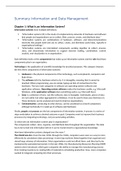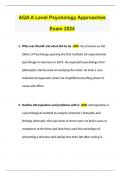Summary Information and Data Management
Chapter 1: What Is an Information System?
Information systems have multiple definitions:
“Information systems (IS) is the study of complementary networks of hardware and software
that people and organizations use to collect, filter, process, create, and distribute data.”
“Information systems are combinations of hardware, software, and telecommunications
networks that people build and use to collect, create, and distribute useful data, typically in
organizational settings.”
“Information systems are interrelated components working together to collect, process,
store, and disseminate information to support decision making, coordination, control,
analysis, and visualization in an organization.”
Each definition looks at the components that make up an information system and the role that those
components play in an organization.
Technology is the application of scientific knowledge for practical purposes. This category imposes
the first three components of information systems:
1. Hardware is the physical components of the technology, such as keyboards, computers and
flash drives.
2. The software tells the hardware what to do. It is intangible, meaning that it cannot be
touched. When programming, you are simply typing out lists of instructions for the
hardware. The two main categories in software are operating-system software and
application software. Operating-system software makes the hardware usable, e.g. Microsoft
Windows, while application software does something useful, e.g. Microsoft Excel.
3. Data is a collection of facts. Just like software, data is intangible. Individually, pieces of data
are not useful, but when aggregated in a database, it can be used to base your decisions on.
These decisions can be analyzed and used to improve organizations.
4. Communication, connecting to other devices, can be considered as a fourth component,
although technically it is made up of software and hardware.
Finally, people and process are the last components of information systems. A process is a series of
steps undertaken to achieve a desired outcome or goal. Companies want to improve their business
processes by integrating technology, not just automating activities.
So what roles do information systems play in organizations?
The components collect, store, organize, and distribute data throughout the organization. The data
has to be turned into information before it can be transformed to organizational knowledge.
How have information systems changed over the years?
The Mainframe Era: From the late 1950s through the 1960s, computers were seen as a way to more
efficiently do calculations (data processing). It were big machines linked together that organized and
stored large volumes of information. Most organizations could not afford them, and they had to be
maintained by specialized personnel. In the late 1960s, the Manufacturing Resources Planning (MRP)
systems were introduced, which gave companies the ability to manage the manufacturing process:
from tracking inventory to creating bills of materials to scheduling production. Now, more companies
wanted to integrate computing into their processes.
, The PC Revolution: In 1975, the first microcomputer was announced. First by Apple, then by IBM
together with Microsoft. The PC was easy to copy for other companies. They were used for word
processing, spreadsheets, and databases, and were not connected to a network.
Client Server: In the mid-1980s, businesses began to connect their computers together as a way to
collaborate and share resources, although mostly within one company. Software companies
developed applications that allowed multiple users to access the same data at the same time, and e-
mail gained popularity. Finally, the first Enterprise Resource Planning (ERP) systems were developed,
which are able to run an entire business with separate modules for e.g. accounting, finance, and
inventory.
The World Wide Web and E-Commerce: The internet was invented in 1969, although it was
unsuitable to use in business, except for e-mail. In 1989, the World Wide Web was invented, making
the network accessible for everyone. This led to the dot-com boom in the late 1990s.
Web 2.0: a new type of interactive website, where you did not have to know how to create a web
page or do any programming in order to put information online, led to disintermediation: technology
replacing a middleman in a transaction, e.g. video rentals went out of business. Policy-makers could
not keep up with the changes.
The Post-PC World: Sales of the PC are now beginning to decline as sales of tablets and smartphones
are taking off, using “cloud” computing to store your information.
People always assumed that implementing (more) information systems would lead to competitive
advantage. Others compared it with electricity: it should be managed to reduce costs, ensure that it
is always running, and be as risk-free as possible. Yet, some companies (Walmart) have used IT for
competitive advantage, e.g. by sharing inventory records with suppliers.
Chapter 3: Software
Software can be divided into operating systems and application software.
The operating system…
1. manages the hardware resources of the computer;
2. provides the user-interface components;
3. provides a platform for software developers to write applications.
Computing devices have operating systems such as Windows, while mobile devices run iOS or
Android. Businesses did not start using a graphical user interface until 1990 when Windows 3.0 was
released, which was an application that ran on top of IBM’s Disk Operating System (DOS). Other
computer operating systems include Apple and Linux.
Microsoft software is dominant in the business world, because almost all businesses used IBM
mainframe computers. After this, they all bought personal computers compatible with IBM’s







